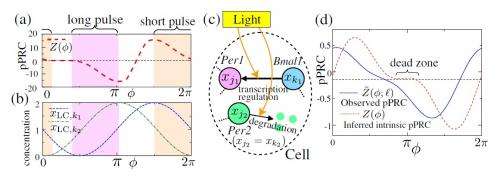September 12, 2014 feature
How did evolution optimize circadian clocks?

(Phys.org) —From cyanobacteria to humans, many terrestrial species have acquired circadian rhythms that adapt to sunlight in order to increase survival rates. Studies have shown that the circadian clocks in some organisms have certain characteristics, such as multiple light input pathways, different gene expression patterns by different light pulses, and the presence of "dead zones" when the clock seems to become insensitive to light stimuli.
Now in a new study published in Physical Review Letters, Yoshihiko Hasegawa at The University of Tokyo and Masanori Arita at the National Institute of Genetics in Shizuoka and the RIKEN Center for Sustainable Resource Science in Kanagawa, all in Japan, have discovered new insight into these characteristics.
The scientists show that each of the above-mentioned experimental observations can be explained by a model that is based on the optimization of two trade-off properties: the "regularity" to keep time precisely, and the "entrainability" or flexibility to adjust the internal time to synchronize with daylight.
Simultaneously maximizing both properties is very difficult because high regularity means less flexibility to adjust, while high entrainability means more vulnerability to noise and thus less regularity.
"One key goal in chronobiology is to identify the primary selective pressure which demands the existing circadian oscillatory system," Hasegawa told Phys.org. "Our theory strongly indicates that entrainability and regularity are the primary selective pressures through evolution of the clock."
To optimize these two properties, the scientists derived a solution using optimal phase-response curves, which show how perturbations to the circadian rhythm can either delay or advance the cycle. Building on their previous research on phase-response curves, the researchers accounted for multiple light input pathways, in accordance with real circadian clocks.
The model provides several insights into circadian clocks at the molecular level. For instance, the model shows that role sharing between two input pathways yields a synchronization advantage, and agrees with experimental evidence for the advance and delay roles of two different input pathways.
The model also shows that long and short light pulses affect the expression of two different genes differently, also in agreement with experimentally observed gene expression patterns. The scientists explain that, given that periodicity is widespread in genes, understanding circadian rhythms could have far-reaching consequences.
"Recent experimental studies suggested that expressions of more than half of genes in organs exhibit periodic patterns," Hasegawa said. "Therefore, the clock orchestrates most of our physiological activities, and hence unveiling biological mechanisms requires an understanding of circadian clocks."
In addition, the model shows that optimal circadian rhythms have dead zones, and even explains why human circadian rhythms appear not to have a dead zone. The reason is that the observed phase-response curve differs from the intrinsic one, which does in fact have a dead zone.
In the future, the model could lead to further insight into circadian rhythms at both the molecular and behavioral levels.
"We are planning to use our theory to identify unknown light-sensitive molecules in the clock," Hasegawa said.
More information: Yoshihiko Hasegawa and Masanori Arita. "Optimal Implementations for Reliable Circadian Clocks." Physical Review Letters. DOI: 10.1103/PhysRevLett.113.108101
Journal information: Physical Review Letters
© 2014 Phys.org

















